|
Jewel in the Crown - Aurangabhad & Udaipur, India
Greetings once again from India. Now that we have been here awhile, we are finally
adjusting to the cryptic jigsaw puzzle that is India,
where the pieces just refuse to fit. Where the unexpected approaches and wants to sit next
to you. The disorienting unpredictability can only be
tamed by surrendering a sense of structure and
just going with the flow.
When we finally left Bombay, we took our first ride
on
the legendary Indian railway, a comprehensive
spiderweb
throughout the country, where the terms first and
second class are relative and third is something you
don't want to mention. Just reserving a ticket is a
bureaurocratic nightmare lasting over an hour, and
that's
only after figuring out which of the thousands of
trains is going your way. For tickets, you can get
1st AC, 1st Sleeper, 2nd Sleeper, 2nd seat, RAC,
Wait-list, Tourist quota tickets or just get on without a
ticket and hope for the best. We got 2nd class
sleeper.
How bad could it be?
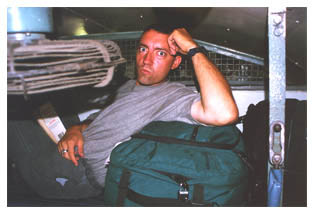
Well think cattle car. Think open compartments with
twice the number of people for the allotted seats,
open
windows with bars over them, and people sleeping
everywhere. And then there is the incessant cry of CHAI, CHAI, CHAI
and the guys coming through with barrels of tea. Actually, that was the
impressive feat, the food service. These railway guys
actually
manage to serve two meals a day to you at your
seat/bit of floor without you moving an inch. Then there are the
local vendors who board at every stop, crawl
over people in the aisles, serving up
quite good snacks like samosa, chapatis, curries, namkeens and
chat. Or you can just deboard and check out the smorgasboard of railway
snacks in the depot. And
so goes the train, actually a pretty efficient and
extremely cheap way to travel around the country, and
the Indians do. They travel with a vengence, and
bring
everyone of their extended family and relatives and huge picnic meals
aboard the trains.
Our first stop after Bombay is the town of Aurangabad,
home to the UNESCO World Heritage sites of the Ajanta
and Ellora Caves. The Buddhist Caves of Ajanta date
from 200 BC to 650 AD and are famous for the
amazing cave frescoes depicting the life of the
Buddha.
The caves were used as a solitary monestary by
Buddhists monks until they were lost to the world for
a thousand years and only rediscovered in 1819. One
interesting feature was the Victorian graffiti
littering the walls, an unfortunate result of early
tourism. The site itself is in a remarkable
crescent shaped valley with the caves carved into the
sheer walls that drop into a forested ravine.
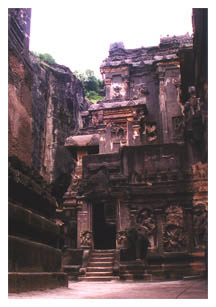 Ellora, on the other hand, is renowned for
its Buddhist, Hindu and Jain(a mix of the two) temple
sculptures. Each religion continued to build temples on top and next to the previous religion making for
an interesting mix.
The carved temples were built completely from stone carved away from the
rocky hills, and extremely intricate, detailing the entire stories of
the Hindu epics like the Mahabharat. Ellora, on the other hand, is renowned for
its Buddhist, Hindu and Jain(a mix of the two) temple
sculptures. Each religion continued to build temples on top and next to the previous religion making for
an interesting mix.
The carved temples were built completely from stone carved away from the
rocky hills, and extremely intricate, detailing the entire stories of
the Hindu epics like the Mahabharat.
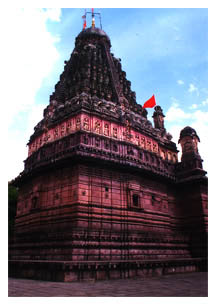 We
stayed in Aurangabhad, a nice central loation for visiting both sites. I
would recommend the Maharashtra Tourism Board Tour, if only for the
direct transportation to both places. Our bus was filled with Indian
tourists and Ajanta was a good two hours away. The Same Tourist Board
Tour of Ellora took in some local wonders. There is a Shiva Lingum
temple there that is one of fourteen across India and a very holy place
of pilgrimage. We
stayed in Aurangabhad, a nice central loation for visiting both sites. I
would recommend the Maharashtra Tourism Board Tour, if only for the
direct transportation to both places. Our bus was filled with Indian
tourists and Ajanta was a good two hours away. The Same Tourist Board
Tour of Ellora took in some local wonders. There is a Shiva Lingum
temple there that is one of fourteen across India and a very holy place
of pilgrimage.
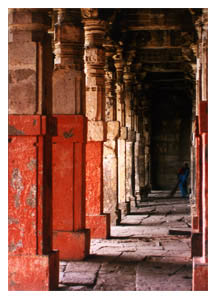 In the
town of Aurangabhad was a beautifully preserved fortress. We walked
through a nearly deserted site, and our only company was a few local
women who cleaned the temple shrine as a meritous act of good
karma. In the
town of Aurangabhad was a beautifully preserved fortress. We walked
through a nearly deserted site, and our only company was a few local
women who cleaned the temple shrine as a meritous act of good
karma.
From
Auranagabhad, to move on, we
boarded a bus to Jagoan, a nearby, convenient trailhead for us to catch
the bus north to Rajasthan. We arrived, just in time to experience the
first of our many woes with the Indian election process. The town was
under curfew and everything was closing, as we scrambled to find some
food and a place to stay. The next morning, we left on the 24 hour train
to Udaipur. We made one stop en route in Ahmedabhad, the heart of
Gujurat. There, on the advice of a fellow passenger and local, we took
in a Gujarati thali, a slightly sweet and always spicy range of dishes
served in the traditional thali style, all you care to eat!
On to Rajasthan, the Indian desert wonderland, home
of
the Rajputs, warrior clans that have controlled the
area for a thousand years according to a code of
chivalry and honor that rivaled the medieval
knights.
Rajput warriors fight til the end, and when no hope
was
left, they declared jauhar. This grim ritual had the
women and children committing suicide on a pyre, while
the men rode out to certain death. Rajasthan is a
land of forts, fairytale castles, and camels.
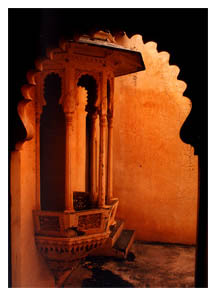 Our first stop is Udaipur, made famous in the James
Bond flick Octopussy, which incidentally shows at all
the budget restaurants as a means of attracting
customers. After watching it again, we realized it is
not one of the better 007's, but there was something
magical about watching the movie on a rooftop
restaurant and looking at all the same scenery
surrounding you. In the movie, there are frequent shots of the
fort on the hill overlooking Udaipur. Our first stop is Udaipur, made famous in the James
Bond flick Octopussy, which incidentally shows at all
the budget restaurants as a means of attracting
customers. After watching it again, we realized it is
not one of the better 007's, but there was something
magical about watching the movie on a rooftop
restaurant and looking at all the same scenery
surrounding you. In the movie, there are frequent shots of the
fort on the hill overlooking Udaipur.
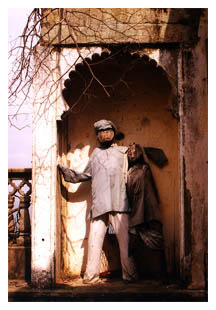 The fort
itself, however stylized in the movie, was in fact deserted and on the
edge of ruin. It had been taken over by the local army barracks and now,
the only inhabitants were a few bored Indian Army officers engaged in a
game of cards. They paid us no attention. The fort
itself, however stylized in the movie, was in fact deserted and on the
edge of ruin. It had been taken over by the local army barracks and now,
the only inhabitants were a few bored Indian Army officers engaged in a
game of cards. They paid us no attention.
When
the army was gone, the couple of the house kept watch.
The most famous site is the chi-chi
Lake Palace Hotel built in the midst of the large
Pichola Lake. The Palace appears to float above the
water. Built as an extreme indulgence by one of the
mahajaras of Udaipur, he first constructed the Palace
and then put a lake around it. Then off on the shore itself, rises
the spectacular City Palace, another indulgence of mirrored halls,
jeweled architecture and Rajasthani
painting. The complex is stunning at night, reflected in the lake.
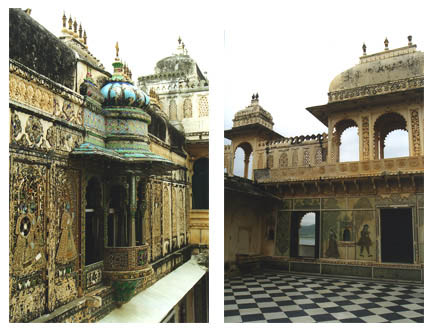
The other striking
thing about Udaipur is the amazing number of our
bovine friends that roam the streets. Here, cows have the right of way, and an auto-rickshaw would rather
plow into you than hit a cow and risk bad karma
in his next life. At night, the streets are eerily
empty save for the herds of cows bunking down for the
nights in doorways and alleys. Although we keep
asking,
nobody seems to know where the cows go to die.
Here
in Udaipur, we made the acquaintance of Rajesh, an young, most curious
fellow. He was about 15 and spoke quite good English. We met him right
outside his school as he was exiting, and he decided to follow us,
practicing his English. Thoroughly pestered, we kept trying to throw him
off, but he kept at it, until we gave in and surrendered. He turned out to
be quite a nice guy. We went to his home and met his family. Turns out
his father is a photographer, and his father also a photographer, but
not just any one, the Royal Mahajara's very own. He was long gone, but
his work lived on. I expressed an interest in it, and Rajesh's father
immediately pulled out a dusty box from under a bed and opened it to
reveal a treasure trove of old-time glass negatives and amazing black
and white photographic prints of royal court life. We lingered over
hyper-clear photos of the last Maharaja of Udaipur, esconsed in his
Palace high on the hill. The same rooms we had visited earlier in the
day, were now coming alive beneath our fingertips. Shy women in saris
and veils danced for his camera, peacock feather fans blurred as they
swayed back and forth, head up by pitch black servants. The Maharaja
himself was a freak of nature, an incestuous abomination, sired of blood
lines so completely crossed. I could not believe that these photos sat
hidden away in this unlikely home when they deserved to be at a museum.
We spent the remainder of our time with Rajesh and his family. His
mother henna painted my hands, and Rajesh took us on a private tour of
the town, showing us all the sights from a local perspective.
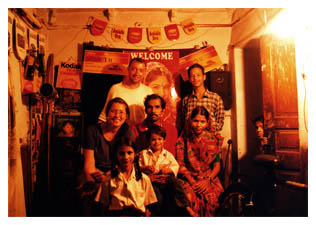
Rajesh
and family with us in their home which doubled as his father's studio.
Our final experience in Udaipur was taking in a Bollywood Hindi
movie called Taal which literally means 'the beat of
passion!' with Rajesh. Its funny how you can watch a three hour
movie and understand exactly what's going on without
understanding a word of the dialogue. Well, this
movie
had it all. They sang, they danced, they fought, they
kissed and made up. The classic tale of forbidden
love
between a rich boy and a poor girl, but then the girl
makes it big (by singing and dancing of course) and
they live happily ever after. And there was even a
scene that seemed suspiciously similar to a Coke
commercial complete with the AAAAAAAH! We highly
recommend it as escapist over-the-top cheesy fantasy,
and I just loved the costumes. As we said before, movies
are big business here in India. The place was mobbed.
Every seat was taken. As in other countries outside
the US, we had assigned tickets, but here's where it
got strange. The doors opened and people flooded into the auditorium, clamoring to find their seats. Well
they start the movie as soon as the doors open, not
when the people are seated. Then, when everyone is
seated and watching the movie, the ticket taker
begins
to make his rounds, THROUGH EVERY AISLE, collecting
the tickets, and shining his flashlight in your face
if you don't hand it over quick enough. Definately
worse than any late-comer, he crawls over every
person, and if there is not enough room for him, he
rudely jerks the seat of the person in front, forward
to make room. Most interesting!
Over and out
ann and doug
index | back
| next |
